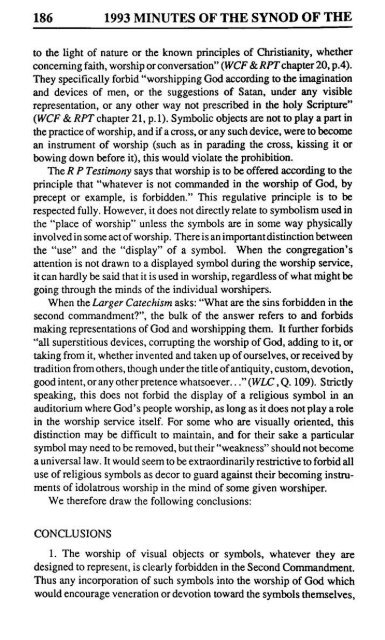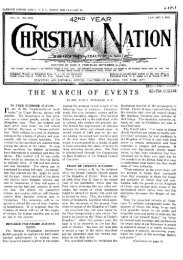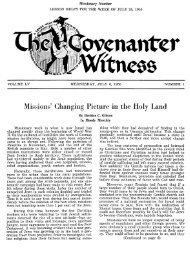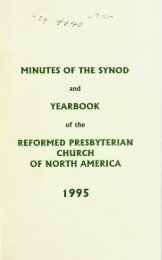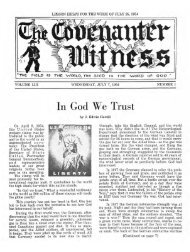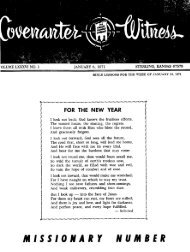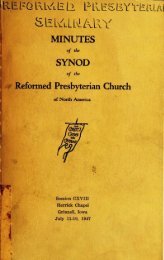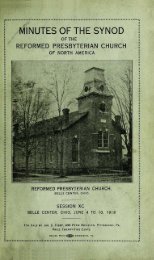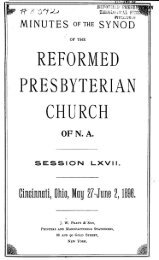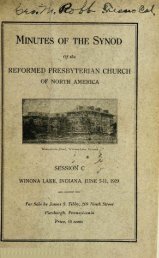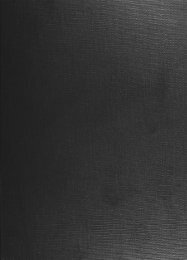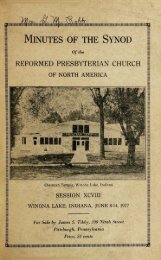Reformed Presbyterian Minutes of Synod 1993
Reformed Presbyterian Minutes of Synod 1993
Reformed Presbyterian Minutes of Synod 1993
- No tags were found...
You also want an ePaper? Increase the reach of your titles
YUMPU automatically turns print PDFs into web optimized ePapers that Google loves.
186 <strong>1993</strong> MINUTES OF THE SYNOD OF THEto the light <strong>of</strong> nature or the known principles <strong>of</strong> Christianity, whetconcerning faith, worship or conversation" (WCF 8cRPT chapter 20, p.4).They specifically forbid "worshipping God according to the imaginationand devices <strong>of</strong> men, or the suggestions <strong>of</strong> Satan, under any visiblerepresentation, or any other way not prescribed in the holy Scripture"(WCF & RPT chapter 21, p. 1). SymboUc objects are not to play a part inthe practice <strong>of</strong> worship, and if a cross, or any such device, were to becomean instrument <strong>of</strong> worship (such as in parading the cross, kissing it orbowing down before it), this would violate the prohibition.The R P Testimony says that worship is to be <strong>of</strong>fered according to theprinciple that "whatever is not commanded in the worship <strong>of</strong> God, byprecept or example, is forbidden." This regulative principle is to berespected fully. However, it does not directly relate to symbolism used inthe "place <strong>of</strong> worship" unless the symbols are in some way physicallyinvolved in some act <strong>of</strong> worship. There is an important distinction betweenthe "use" and the "display" <strong>of</strong> a symbol. When the congregation'sattention is not drawn to a displayed symbol during the worship service,it can hardly be said that it is used in worship, regardless <strong>of</strong> what might begoing through the minds <strong>of</strong> the individual worshipers.When the Larger Catechism asks: "What are the sins forbidden in thesecond commandment?", the bulk <strong>of</strong> the answer refers to and forbidsmaking representations <strong>of</strong> God and worshipping them. It further forbids"all superstitious devices, corrupting the worship <strong>of</strong> God, adding to it, ortaking from it, whether invented and taken up <strong>of</strong> ourselves, or received bydadition from others, though under the title <strong>of</strong> antiquity, custom, devotion,good intent, or any other pretence whatsoever..." (WLC ,Q. 109). Stricdyspeaking, this does not forbid the display <strong>of</strong> a religious symbol in anauditorium where God's people worship, as long as it does not play a rolein the worship service itself. For some who are visually oriented, thisdistinction may be difficult to maintain, and for their sake a particularsymbol may need to be removed, but their "weakness" should not becomea universal law. It would seem to be exdaordinarily restrictive to forbid alluse <strong>of</strong> religious symbols as decor to guard against their becoming instmments<strong>of</strong> idoladous worship in the mind <strong>of</strong> some given worshiper.We therefore draw the following conclusions:CONCLUSIONS1. The worship <strong>of</strong> visual objects or symbols, whatever they aredesigned to represent, is clearly forbidden in the Second Commandment.Thus any incorporation <strong>of</strong> such symbols into the worship <strong>of</strong> God whichwould encourage veneration or devotion toward the symbols themselves,


